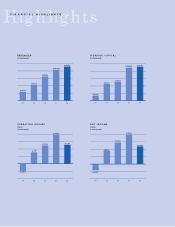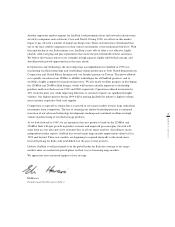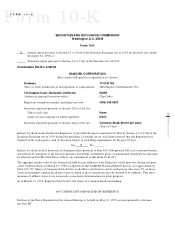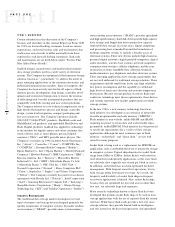SanDisk 1998 Annual Report Download - page 14
Download and view the complete annual report
Please find page 14 of the 1998 SanDisk annual report below. You can navigate through the pages in the report by either clicking on the pages listed below, or by using the keyword search tool below to find specific information within the annual report.
SanDisk Corporation
9
small form factor, must be lightweight, shock and vibration
tolerant, non-volatile and interoperable with computer
systems and software that can process and manipulate data,
audio and digital images.
Industrial/Communications M arket. Emerging applications in the
industrial market encompass a wide variety of electronic
systems used by personnel such as inventory controllers,
service technicians, route salesmen, delivery crews, meter
readers, car-rental service employees, physicians, real estate
agents, insurance agents and public safety officers. The systems
used by these workers are often subjected to rough handling,
used in a variety of temperature and humidity conditions and
required to operate for extended periods of time without
external power sources or frequent battery changes. The
information collected by these individuals is critical to the
successful operation of their business or agency and hence
must be stored reliably regardless of the operating environment.
In addition, the information is frequently processed by a cen-
tral computer system at some point (typically the end of the
work day or night) and must therefore be easily transferable.
The communications market has applications that are begin-
ning to require new types of data storage. For example, com-
munications switches and cellular base stations require data
storage in environments such as subway stations or outdoor
telephone booths that are subject to shock and vibration and
a wide range of temperature and humidity conditions.
In the fiscal years ended December 31, 1998, 1997 and 1996,
product sales to the Company’s top 10 customers accounted
for approximately 59% , 67%, and 71% , respectively, of the
Company’s product revenues. In 1998, one customer accounted
for 10% of the Company’s total revenues. In 1997, no single
customer accounted for greater than 10% of total revenues.
During 1996, one customer accounted for approximately
26% of the Company’s total revenues. The Company expects
that sales of its products to a limited number of customers
will continue to account for a substantial portion of its
revenues for the foreseeable future. The Company has also
experienced significant changes in the composition of its
major customer base from year to year and expects this
pattern to continue as certain customers increase or decrease
their purchases of the Company’s products as a result of
fluctuations in market demand for such customers’ products.
Sales to the Company’s customers are generally made pursuant
to standard purchase orders rather than long-term contracts.
The loss of, or significant reduction in purchases by the
Company’s major customers, could have a material adverse
effect on the Company’s business, financial condition and
results of operations. See “Factors That May Affect Future
Results—Sales to a Small Number of Customers Represent a
Significant Portion of Our Revenues.”
Products
SanDisk’s storage products are high capacity, solid-state,
non-volatile flash memory devices which comply with PC Card
ATA and/or IDE industry standards. The Company offers a
broad line of flash data storage system products in terms of
capacities, form factors, operating voltage and temperature
ranges. The Company’s current product families include
removable CompactFlash, FlashDisk and MultiMediaCard
products, embedded FlashDrive products and Flash ChipSets.
All products use the Company’s proprietary 512 byte sector
erase flash memory chips and intelligent controller. The
Company’s products are compatible with the majority of
today’s computing and communications systems that are
based on industry standards. The Company’s products, as
of December 31, 1998, are listed in the following table:
PRODUCT FAMILY FORM FACTOR UNCOMPRESSED CAPACITY
(in million bytes)
CompactFlash 36.4 mm x 4, 8, 10,15, 20, 30,40, 48,
(Removable) 42.8 mm x 3.3 mm 64, 80,96
FlashDisk PC Card Type II 4, 8, 10,20, 40, 60,85, 110
(Removable) 150,220, 280,350,440
Flash ChipSet 2 chips 4, 8, 16,32
(Embedded)
FlashDrive 1.8 in., 2.5 in. 20, 40,60, 80, 100, 220,
(Embedded) 3.5 in. 350,440
MultiMediaCard 32 mm x 24 mm x 4, 8, 16
(Removable) 1.4 mm
Unlike rotating disk drives, the Company’s flash products
are solid-state devices. The Company’s products are very
reliable. They have no moving parts that are subject to
mechanical failure. The Company’s products are non-volatile,
meaning that no on-going source of power is required in
order for the products to retain data, images or audio indefi-
nitely. Flash is noiseless, considerably lighter, more rugged
and consumes substantially less power than a rotating disk
drive. The Company’s CompactFlash, MultiMediaCard and
Flash ChipSet, are small enough to be used in many of the
newer, miniaturized electronic systems being developed
today.
CompactFlash. The Company’s CompactFlash products pro-
vide full PC Card ATA functionality but are only one-fourth
the size of a standard Type II PC card. CompactFlash’s com-
pact size, ruggedness and low-power requirements and its
ability to operate at either 3.3V or 5V make it well-suited
for a range of current and next-generation, small form factor
consumer applications such as digital cameras, PDAs,
personal communicators, pagers and audio recorders.
CompactFlash products provide interoperability with systems
based upon the PC Card ATA standard by using a low-cost
passive Type II adapter. CompactFlash cards are available in
capacities ranging from 4MB to 96MB.
FlashDisk. The Company’s FlashDisk products are used in
storage, data backup and data transport applications.
FlashDisk products are available in Type II form factor with
capacities ranging from 4MB to 440MB.
























